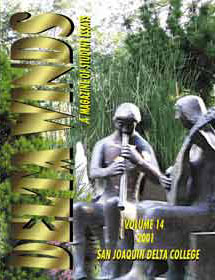The Bookmakers
 Delta Winds: A Magazine of Student Essays
Delta Winds: A Magazine of Student Essays
A Publication of San Joaquin Delta College
2001
The Bookmakers
Robert Phillips
Imagine living the "life" of the latest issue of your favorite magazine at the library. At first crisp and shiny, you feel the future seems as promising as your bright cover. But smudges and tears soon bring into doubt whether you will survive the onslaught of eager readers. Oh sure, the librarian may slap some tape or plastic covers on, but it only accentuates your fragile nature. Then, after a couple of months in the spotlight, your star fades drastically. It seems you are doomed to finish your days alone, dirty -- and misplaced! This is a story all too common and just as tragic, unless your caretaker is an understanding sort -- and she knows a library bookbinder!
There you will be reunited with your brothers and together protected between the hard covers of a bound volume. You will see your cousins -- journals, theses, and old or new monographs -- also arrive here for rehabilitation. The transformation takes place slowly, for there are over forty distinct steps in this largely manual process. But when you are back in the librarian's hand you'll scarcely be recognizable. With your title and call number deeply embossed in real gold on the rugged buckram spine, you'll be hard to miss shelve now! And see how the edges of your pages have been trimmed -- so smooth and cool to the touch. Luxurious!
The people who work at a library bindery appreciate the aesthetics of their work at least as much as do their customers or library users. But unlike the recipients, these craftsmen must prove their devotion to that ideal repeatedly and in many ways. Whether sitting at a sixty-year-old sewing machine or this year's computer keyboard, they have developed an acquired habit of painstaking attention to detail. How exactly is their aim accomplished?
First, materials to be bound are inspected for completeness and soundness, then forwarded to a back-trimming station, where adhesives and staples are removed if necessary. Next, one of two things happens -- volumes to be "bound as is" are sewn or glued together, or those to be "custom collated" are first plucked free of unwanted pages. This can be a considerable portion of the total, as in the case of some medical journals containing about 80% ads.
The sewing of bound journals is the oldest of the traditional methods in what is a relatively conservative craft. At the turn of the 20th century, this was done by hand -- one section at a time being whip-stitched until the entire thickness of a volume was built up. In the late 1920's a revolutionary machine was invented to side-sew books much more quickly, though not automatically. With very few changes, these "oversew" machines are still in use today. Sewn books are then copiously back-glued by hand with a large round brush to fully integrate the spine. The result will be a book that is very nearly indestructible -- ideal for the high-usage library.
In contrast to the robust oversewn volume is the elegant and super-flexible double-fan adhesive bound book. Not feasible until the advent of modern adhesives which are both strong and permanently flexible, this is the method of choice for lightweight and lay-flat books. Materials are square-notched to a depth of about one millimeter along the binding edge, then swept across a glue-laden roller in two directions. This has the effect of "tipping" each page equally to the next, resulting in a perfectly balanced spine. A layer of stretchable material is applied over the spine as reinforcement.
When dry, the spines of both oversewn and fan-bound books are "nipped" square in a hydraulic press, then trimmed smooth on three sides at a guillotine cutter (watch your fingers!). Then most are "rounded & backed" at a (what else?) rounder-backer machine. This gives spines the familiar shape, which is at once pleasing and functional. Thought to be an invention of early German binders, this shape keeps the back of a book from caving in and gives the cover and outer leaves a good hinge line. Of course, the Germans had to achieve this result entirely by hand via hammer and vise -- which is altogether too much work!
The last step performed on the book block before it is mated to its cover is back-lining. A layer of stout cotton cloth is glued to the spine and part of the sides of the book. This will anchor the book firmly in its cover (or case, as it is called). Sometimes decorative headbands are attached to head and foot across the spine at this time as well. Finally, the book is measured up for the parts that will be used to construct its cover. They are tailored to fit each book individually, because no two volumes are identical in size. A pair of dense binder's-boards is cut to size, as well as a lighter flexible paper inlay for the spine portion of the case. The cover is made separately from these parts: Glue is applied to a sheet of special coated cloth called library buckram between the rollers of a Potdevin(tm) machine. It is then laid wet side up over a light box and the remaining pieces placed accurately on it. The corners are cut by hand at a 45° angle and the edges turned onto the inside of the cover with the aid of a pneumatic stamping machine.
At last, the book is ready to be "cased-in." First it's dipped between two glue-laden rollers, and then poised to have the case applied by hand. After a suitable delay, a powerful heated press sets the glue permanently. Voila! -- A finished book, and a fitting place of honor for your favorite magazine.






